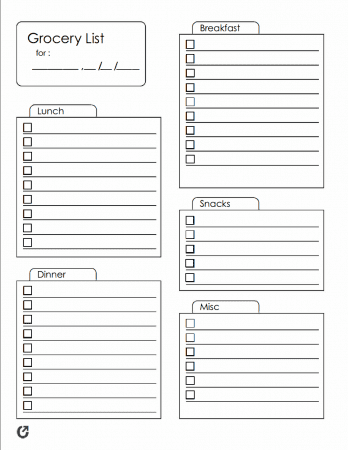
A grocery list template is a chart that allows individuals to plan for the foods and household goods they want to purchase at the store. There are many different styles of grocery list templates to accommodate individual needs. For example, someone on a special diet would choose a separate chart from someone focusing on a budget. Users looking to create additional categories can edit or change the list after downloading it.
Individuals on a new diet often prefer to use grocery lists templates to help them stick to healthy foods. Likewise, someone with a medical condition, such as high cholesterol, can complete a chart ahead of time to ensure they choose the right foods when shopping. To further assist customers with health-related needs, grocery stores have free fliers that include mindful choices. Paper and electronic advertisements also inform shoppers of weekly sales and discounts to save money.
Doctors’ offices and nutritionists can require patients to create a grocery list. However, individuals can make one for personal reasons, as well. No matter the reason, the person begins by downloading one of the following PDFs or Word templates. Then, they complete it electronically or print it to enter the details by hand.
Overall, grocery lists have many benefits: they cut overspending, remind the shopper of essential ingredients to buy, and assist in easy meal planning. Furthermore, the intent of a grocery list is the same across the board – shop better, smarter, and healthier.

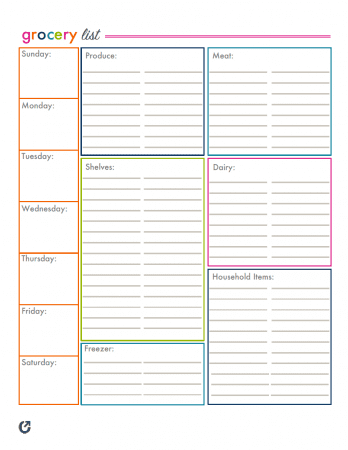

Follow the steps below to create a helpful and reliable grocery list.
Step One – Determine Goal
When making and organizing a grocery list, consider the overall reason for the shopping trip. For example, you may want to plan meals for the week, purchase foods for a new diet plan, or stock up on pantry staples. However, you might also have another personal motive for making a list. Regardless, understanding the primary purpose of the grocery list can help you choose the most appropriate template.
Step Two – Select a Template
Grocery list templates have many different organizational structures and designs. Choosing a format that best suits the list’s purpose is vital. For instance, an individual might sort the list based on the grocery aisle layout. Another person might find it more helpful to sort the list by their daily meals (along with the necessary ingredients) for the week. Other templates have a checklist format with typical foods in a category, such as vegetables, refrigerated items, baking needs, and similar groups.
Step Three – Check the Pantry
After choosing the proper template, check the pantry, refrigerator, and freezer for items currently on hand. This process ensures that you do not purchase an item if you already have it. Similarly, it helps identify low or empty staples, such as butter, milk, eggs, or flour.
Step Four – Bring List to Grocery Store
With the grocery list template filled out and in hand, head to the grocery store. Use the list while shopping to cross off items as you pick them up. This step prevents impulse buying – negatively impacting both a diet and budget.
Step Five – Safely Store Grocery List
Instead of throwing away the grocery list, consider keeping it on file to reference in the future. Organizing and storing the list helps identify shopping and eating trends. Those who follow a strict grocery budget might keep the receipt(s), along with the list, to determine how they might cut costs moving forward. Lastly, holding onto the template makes it possible to re-use or skim through it when creating a new list.
A bodybuilding grocery list focuses on meats, dairy, starchy vegetables, and bulk protein powder to help build and maintain muscle. This eating plan is stricter than most, as the individual must have certain foods at specific times during the day. Therefore, bodybuilders should choose a template that suggests realistic options, rather than foods they cannot have, such as alcohol, added sugar, or fried foods.



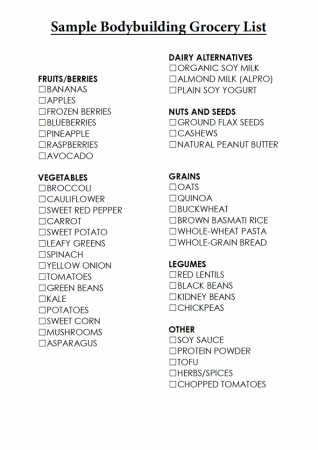
Since healthy eating habits differ from person to person, various grocery list formats exist. Individuals can create their own plans or follow suggestions from another person when incorporating mindful foods into their diet. The Mediterranean, Paleolithic, and Ketogenic diets, for example, are popular diets that allow and restrict certain food items.
Moreover, a Mediterranean diet promotes healthy fats, seasonal vegetables, and a variety of whole grains and fish. It does not allow processed red meats, refined grains, or butter. In this case, a list helps to keep this information organized to ensure that the shopper purchases the right foods.
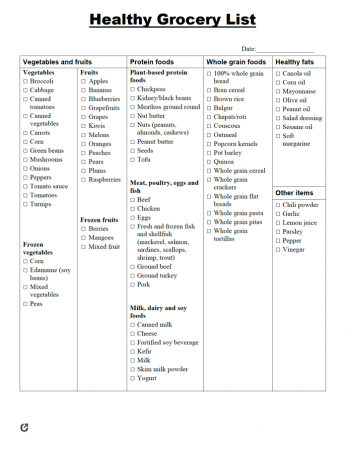
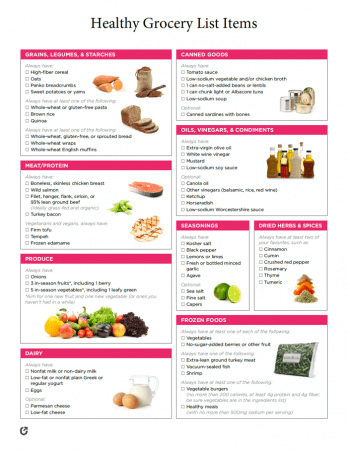
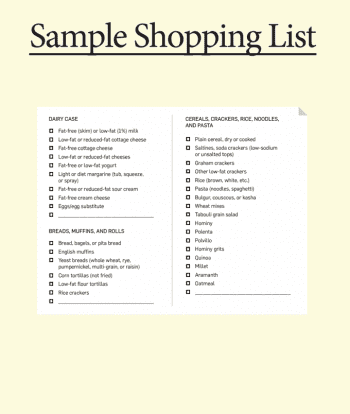
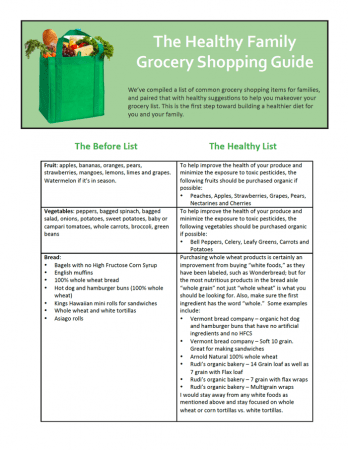
The type of grocery list needed depends on the goal of the list. Athletes training for their next marathon might opt for a list highlighting their macronutrients (i.e., complex carbohydrates, healthy fats, and lean proteins). However, busy parents juggling numerous responsibilities may choose a simple checklist to create quick and easy meals throughout the week. To download the most helpful list for your needs, consider your eating goals and time commitment to shopping or making meals.
This list focuses on well-balanced meals, such as vegetables, whole grains, fruits, dairy, fish, meat, and poultry. These foods promote heart and digestive health, weight maintenance, immunity, bone strength, and quality sleep. They may also have other health benefits that make them a preferred choice. For example, the foods can help lower cholesterol, blood pressure, and risk of developing diabetes and some cancers.
The needs of college students vary. A first-year student living in a dorm with limited kitchen space may resort to quick-cook or microwave meals. This grocery list can feature a checklist of common college-friendly foods, such as rice and pasta meals, frozen dishes, and microwave soup.
On the other hand, a college senior may have their own apartment and a larger budget but still need easy and convenient meals. A grocery list that focuses on weekly meals that share ingredients can assist in smart shopping and better cooking.
When losing weight, consider finding the right foods and sticking to a diet. Grocery lists help you shop for healthy ingredients and follow a set routine. Templates also allow you to add variety to your meals through planning. Similarly, you can include “fun” or new foods in your list to keep your choices exciting.
Cutting back on grocery spending helps you increase your savings or use money in other areas. Creating a budget does not mean you have to cut back on meals or your favorite foods. However, it does mean that you are more aware of prices and take advantage of grocery store discounts.
More specifically, grocery store lists help you plan for weekly deals and choose items that keep costs low. Without a list, shoppers can find it challenging to stick to cheaper options or avoid impulse buying. Therefore, utilizing a budgeting chart and planning skills decreases overall spending.
Preparing and eating meals at home not only provide healthier options, but it also tends to be more affordable and convenient. Since college students have restrictions based on their kitchen equipment, they aim for minimal cooking requirements. In addition, m ost students do not work or have part-time jobs while attending university. Therefore, they typically opt for less expensive grocery items when compared to the average grocery shopper.